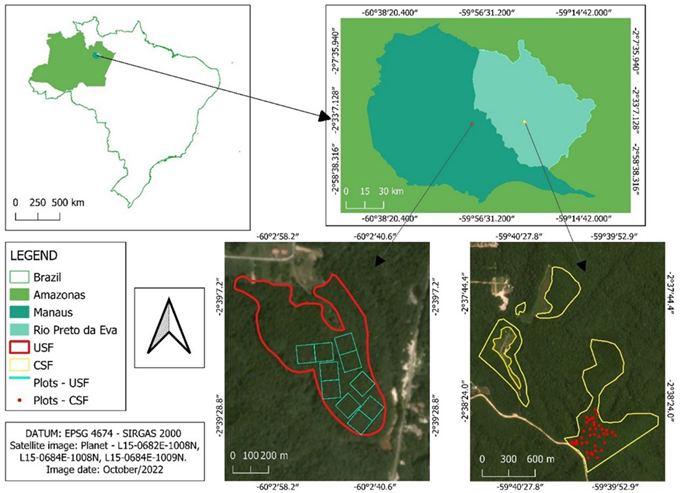ABSTRACT
Sustainable forest management is an important strategy for the conservation of tropical secondary forests. However, knowledge about their potential for timber production is scarce, especially in the Central Amazon. We performed a silvicultural diagnosis in Central Amazon secondary forests to understand their potential for forest management. The diagnosis was carried out in two secondary forest patches at advanced successional stages located 38 km north and 75 km northeast of Manaus. We quantified the commercial tree species, classified their stem quality and growth conditions (crown exposure and liana infestation), and related tree size (diameter at breast height-DBH) to growth conditions. We identified 46 commercial tree species. Goupia glabra, a very important timber species, exhibited the highest density of individuals (more than 95 individuals ha-1). Good and reasonable quality stems accounted for 87% of the commercial trees, with 45 and 42% classified as of good and reasonable quality, respectively. The species composition and stem quality of the examined secondary forests support timber production through sustainable management. Commercial trees predominantly had crowns with low light exposure (63% with a Dawkins index lower than 4) and were liana infested (62% with lianas on some part of the tree), requiring silvicultural treatments to improve growth conditions. The number of trees under suppressed growth conditions (low light and liana-infested) varied according to species and tree size, requiring specific recommendations for silvicultural treatments. These results demonstrate the potential of secondary forests for timber production and provide valuable insights for management strategies aiming at promoting sustainable management to prevent secondary forest deforestation.
Keywords:
Regenerating forests; Alternative timber sources; Vegetation structure; Dominant species; Assisted natural regeneration.

 Assessing the potential of tropical secondary forests in the Central Amazon for timber production
Assessing the potential of tropical secondary forests in the Central Amazon for timber production Thumbnail
Thumbnail
 Thumbnail
Thumbnail
 Thumbnail
Thumbnail
 Thumbnail
Thumbnail
 Thumbnail
Thumbnail
 Thumbnail
Thumbnail
 Thumbnail
Thumbnail
 Thumbnail
Thumbnail







